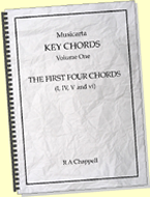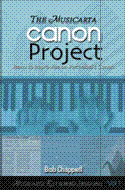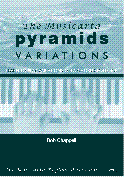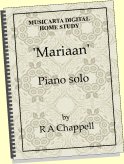|
Comptine – Yann TiersenLESSON ONEThe following material is for personal study use only. Respect artist’s copyright and always conform to the copyright legislation of the country where you live. But first, a word from our sponsors...
Stop Press! Latest Musicarta Home-study Releases!
Click through to the Mister Musicarta YouTube B & R playlist here
Click through to the Mister Musicarta YouTube 12-BAR PLAYLIST here
Click through to the MODES YouTube or Soundcloud playlists here
Click through to the MEPS YouTube playlist here
And now, on with the show!
|
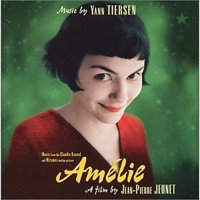
|
Buy the digital sheet music (published by Music Sales) from www.musicroom.com via this link, or buy it in a book - Yann Tiersen: Six Pieces Pour Piano - Volume 2, Editions Bourgès - also from http://www.musicroom.com
Buy the soundtrack (released by Virgin Records)from your favourite online store. |
Using MIDI files to help you learn
Musicarta is now making MIDI files available to help you learn more quickly. The number of the MIDI file relating to the musical examples is shown in the right hand cell of the table underneath the music manuscript or keyboard diagram. The audio clip player is in the left hand table cell.
To benefit, you need to download the files and have an application that can play them. Musicarta recommends MidiPiano, a small, free, reliable application that's easy to download and use. Learn more about playing Musicarta MIDI files here. Download the MIDI files for this module here.
Please take the time to download MidiPiano and the module MIDI files! You only have to do it once, and it will prove a valuable addition to your learning resources. If you need help ‘unpacking’ your zipped MIDI file folder, there are full instructions on the Musicarta MidiPiano page (link via navbar).
Note: All Musicarta MIDI files are also available via the Musicarta MIDI file download page . Bookmark and visit regularly to see what’s on offer!
The four basic chords
First learn and memorise these four left hand chords:

|
YTC_M1 |
Here are the four chords shown on keyboards:
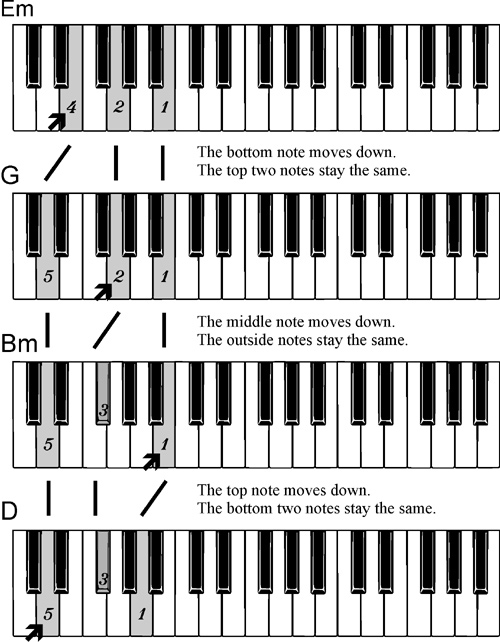
|
YTC_M1 |
Learn the chords with the fingering given. The fingering helps you find the notes when the chord changes.
The Em (E minor) and D chords are in root position - the name-note (root) is at the bottom. The G and Bm (B minor) chords are inversions – the name-note is not the lowest note. The roots (name notes) of all the chords are arrowed.
Voice movement diagrams
Notice the three-line diagrams between the chords. These ‘voice movement diagrams’ make it easier to learn a string of chords by showing how the notes of a chord (‘voices’) move in relation to each other when the chord changes.
Voice movement diagrams can indicate that a voice
- stays the same;
- moves up; or
- moves down.
The three voice movement diagrams in use here ‘say’:

These are the voice movement diagrams as they appear in the music manuscript. In the keyboard diagram, they are tipped on their side.
Study the voice movement diagrams as you play the chords and listen to the audio clip until you can see how they can help you to remember the string of chords. Which note moves? First the bottom note (finger 4 to finger 5), then the middle note (finger 2 to finger 3), then the top note (the thumb moves in).
Bottom, middle, top
The left hand chords are all three-note chords.
The notes of a three-note chord can usefully be referred to as bottom (B), middle (M) and top (T):

This is useful shorthand for describing broken chord patterns, as you will see in the next section.
Breaking the chords up (broken chords)
Your next task is to break the chords up – to play the notes of the chords in a broken chord pattern.
Here is the music and the matching audio file

|
|
YTC_M2 |
The ‘unbroken’ chords are shown, to encourage you to prepare the hand and the fingering. In the audio file, the chords are played then broken up the first time round, for a rehearsal. After that, you play the notes one at a time in the order: bottom, top, middle, top (BMTM), repeating.
NOTE Always ‘prepare the hand position’. Unless you’re already an accomplished keyboard player, it’s pointless trying play a broken chord pattern if you don't even know what the chord is. You will save yourself hours of frustration and achieve your goal much sooner if you follow the Musicarta method. Prepare the chords and know the fingering.
A note on tempo (speed
You do not have to play Comptine as fast as the YouTube performances (MM=100 – 100 beats per minute). The audio examples in this lesson are sometimes much slower. It is much better to play slower and keep in time than to try to play to an ‘official’ tempo and stumble (or give up!). It is essential to practice still more slowly and keep going. No point rushing to the next chord change and crashing!
Yann Tiersen's Comptine is a modal chord structure. Lots of the music YOU like is probably modal. The modern keyboard player needs to know about modes!
|
The MUSICARTA The modes are known as scales for improvisation – and for generating intriguing chord sequences not available in the conventional major/minor key system. Here is methodical, ‘lean’ approach to building a sound and productive knowledge of modes for the modern-styles keyboard player, packed with riffs which will expand your chord vocabulary – and your stock of rhythmic keyboard skills. |
|
Bookmark that 'Learn more' page and come back for a lokk-and-listen presently.
Most of the pieces in the Musicarta Easy Piano Style album are modes-based, too.
|
MUSICARTA EASY The Musicarta Easy Piano Style shows you how to get your hands on the keys and start making music right away! With lots of graphics, full audio and MIDI support and all the solos on Mister Musicarta YouTube, you’re sure to get some beautiful pieces into your repertoire quickly – and learn how to find the music in the keyboard for yourself. |
|
Add right hand notes
Now add some right hand notes. The right hand note we are adding is always an octave above the lowest left hand note.
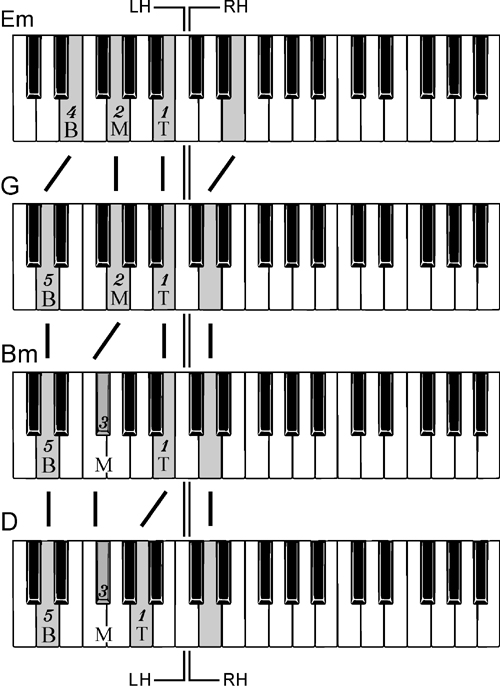
|
|
YTC_M3
|
The audio clip first plays all four chord tones together, then the new right hand note on its own, then the octave-lower bottom note, then the four notes bottom to top.
Using the new right hand note, play four straight right hand crotchets to the bar over the left hand broken chords. Make sure your left hand still plays B T M T.

|
YTC_M4
|
Quite often, as soon as the right hand starts to play, the left hand pattern goes wrong.
The solution is to be quite clear which left hand note (bottom, middle or top) the right hand notes come with. Checking carefully, you can see that the right hand never plays with the left hand top (T) (thumb) note.
In this piece as originally written, the notes in the treble clef above are actually played with the left hand thumb, like so:
(FOR INFORMATION/ADVANCED PIANISTS ONLY!)

This is quite a difficult pattern and a big stretch. Consider playing the left hand like that all the way through the piece (if you want to and you can); otherwise use the suggested easier version.
The next three sections are about improvising, ear training and using home-made musical shorthand to write music down, and playing expressively for relaxation and enjoyment. If you would prefer to get right on with learning Comptine, you can skip forward, but if you do, please make a point of coming back for a look later!
Experiment with making slight variations in what you’ve just learned. For example, instead of just a row of crotchets, make some of the notes two-beat minims. Listen to the next audio clip and try to work out what combination of one- and two-beat right hand notes is used. (This is ‘playing by ear’.)
|
YTC_M5
|
Copy the example – try to play it from the audio clip. (It really doesn’t matter if you come up with something different!)
The rhythm of sometimes crotchets, sometimes minims is a melody in itself. Try to get the most out of it. Here’s another example, with tied right hand notes. Listen hard to work our what the right hand pattern is. Change it, if you like.
|
YTC_M6
|
To see those two right hand patterns written out, skip forward to the ‘Answers’ section. Your next possibility for a slight variation – which, like the variations above, makes the music more interesting to listen to – is: when the right hand plays a note, to miss out the left hand bottom-middle-top-middle (BMTM) note (if it sounds right), like this:
|
YTC_M7
|
Use musical shorthand
Get into the habit of using a musical shorthand – much easier than writing the actual performance down. Here’s a shorthand version of the audio clip just above.

This shorthand has
- crosses where the right hand plays;
- a continuous row of BTMT’s with bar lines every eight (quaver) notes and slashes through the missed-out notes;
- a reminder of the left hand chords with the bottom note (which isn’t always the root) pencilled in.
Musical shorthands are great. They make you:
- Listen – when you write performances down;
- Think about the music – what it’s made of and what to write down;
- Use your memory – because you don't write everything down.
But best of all, you don’t have to wait until you can ‘write music’ (down) to get on with your creative life. Anybody with ears and a pencil can do something!
Type up or write down a row of BTMT’s and see if you can notate (write down) this performance. It’s a combination of one- and two-beat right hand notes and missed-out quavers in the left hand.
|
YTC_M8
|
You are still using the same notes:

This is a 'win-win' activity. You are listening carefully to music and trying things out at the keyboard – the more you do that, the better you get at it. Even if you ‘give up’ and do your own thing, you still win!
Performance notes
We have to be careful not to make learning the piano ‘a rod for our own backs’, always reaching for the next thing and never taking time out to get some enjoyment out of what we can already play, however simple it is.
To enjoy yourself, you have to make it your goal to be carried away by your own playing.
First, commit to playing a beautiful performance.
You might notice that the performances in the audio clips are not very strict in tempo. They speed up and slow down a little as a way of being more expressive (rubato). They also get louder and softer in various places (dynamics).
Try to bring this into your playing. Imitate a concert pianist swaying madly over the keys. (Do this on your own!) You might feel ridiculous, but it helps get expression into your playing. Afterwards, you can forget the swaying madly and still have the expression.
Give yourself permission to ‘mess around’. Listen out for what you think is beautiful and interesting, trust your judgement, and play it to convince your (imaginary) audience.
Now we get the first bit of the melody proper. This is the part that sounds like this:
|
YTC_M14
|
When you start adding the melody to the left hand broken chord patterns, the left hand nearly always slows down. That's fine, but we want to at least keep going! So we simplify the music into what Musicarta calls ‘build-up versions’.
First, ‘prepare the hand positions’ – find the notes you are going to use at the keyboard. There are four underlying chords, and four lots of notes. The right hand here is a stripped-down version – you won’t be playing all the right hand notes yet.
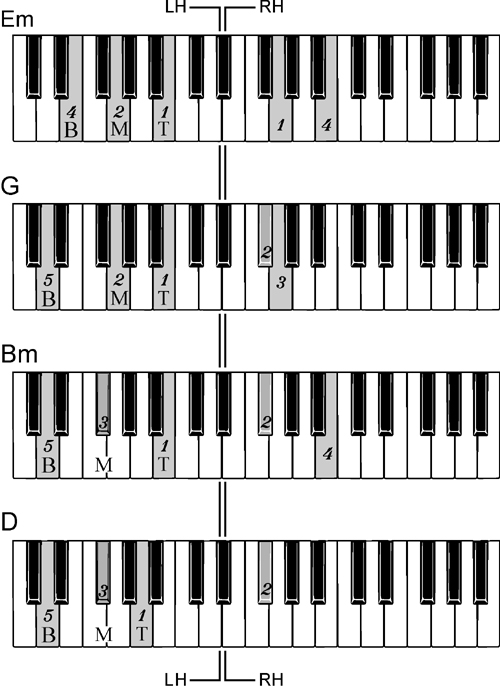
|
|
YTC_M9 |
The right hand fingering for the E minor chord – 1 and 4 – is correct. Also, don’t forget to use the proper left hand fingering.
Now play just chords (not broken) in the left hand and the right hand stripped-down quaver-beat notes.

|
|
YTC_M10 |
This audio example uses only the notes shown in the keyboards above. You copy the pattern and its rhythm. Notice that the 'build-up version' sounds fine just as it is.
Next, you break up the left hand chords bottom-top-middle-top just as before. This sketch will help you work out which (bottom, top, middle) left hand note the right hand notes come with.

|
You can hear the audio of this sketch at the end of the previous audio clip.
|
YTC_M11
|
The actual right hand performance has more notes squeezed in between the quaver-beat notes we’ve been practising. The full set of right hand notes used is shown on these keyboards:
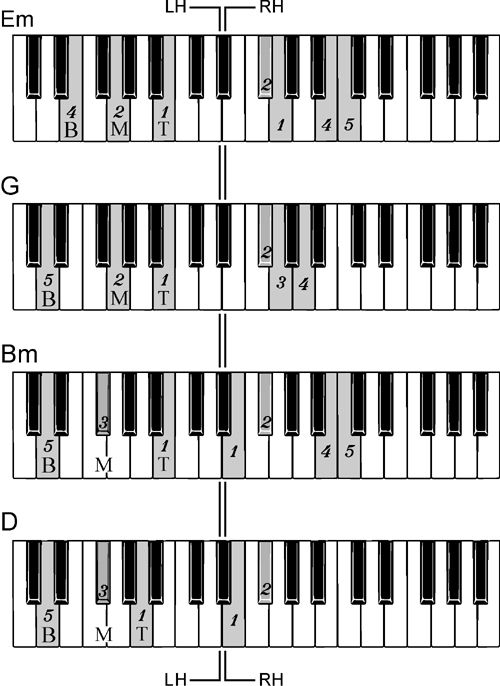
The new notes are all next door to the ones you've already played. The fingering in the first (Em) bar is correct – you pass the second finger over the thumb to play the F sharp.
Here’s another possible build-up version:
|
YTC_M12
|
You have the full right hand melody, but over chords (not broken) on beats one and four.
That's just the 'finding the notes' version above, but t would sound quite all right in a performance, played up to speed. Give yourself official permission to use (and enjoy!) these ‘build-up’ versions. Playing the build-up versions is a way of practising the full version, anyway.
In the end though, you will want to play the melody over the broken chords. The following sketch shows all the right hand notes, correctly lined up above the BMT (bottom-middle-top) letters representing the left hand notes.

|
YTC_M13
|
Note however that it is much better in performance to play the simpler versions in time than to slow down for the ‘proper’ version. Your audience will probably not know that you're simplifying the music, but they will notice if you slow down.
'Answers' section
Here are the two variations on the simple single-note right hand pattern, written out.

|
YTC_M5
|

|
YTC_M7
|
This is the end of Lesson One of Musicarta’s mini-series on Yann Tiersen’s Comptine.
Lesson Two carries straight on - link through here to continue.
There are lots of other free online piano lessons at Musicarta.com. The tabs in the left-hand navigation bar will take you through to the main section pages.
Musicarta digital home study downloads
Are you enjoying playing Yann Tiersen’s ‘Comptine’? Would you like to move towards composing and improvising yourself? It’s not as hard as it sounds! Musicarta has a variety of digital home study downloads designed to structure your efforts and maximise your progress.
The latest additions...
|
The MUSICARTA The modes are known as scales for improvisation – and for generating intriguing chord sequences not available in the conventional major/minor key system. Here is methodical, ‘lean’ approach to building a sound and productive knowledge of modes for the modern-styles keyboard player, packed with riffs which will expand your chord vocabulary – and your stock of rhythmic keyboard skills. |
|
|
MUSICARTA EASY The Musicarta Easy Piano Style shows you how to get your hands on the keys and start making music right away! With lots of graphics, full audio and MIDI support and all the solos on Mister Musicarta YouTube, you’re sure to get some beautiful pieces into your repertoire quickly – and learn how to find the music in the keyboard for yourself. |
|
And now, on with the show!
The three original Musicarta keyboard creativity downloads...
|
KEY CHORDS Vol. 1 Musicarta Key Chords builds your chord vocabulary by introducing the chords you are most likely to come across in any song. You practice the chord changes in contemporary riffs (drum backing tracks are included), with easy step-by-step rhythmic build-up of impressive keyboard syncopation. |
|
||
|
The CANON PROJECT Pachelbel’s Canon in D is perhaps the most famous chord sequence of all time, and the basis of dozens of popular hits. If you can play and understand the Canon chord sequence there isn’t much in popular music harmony you won’t be able to figure out. Its regular structure also make it a great springboard for improvising and composition. |
|
||
|
The PYRAMIDS VARIATIONS The Musicarta Pyramids Variations aims to exceed expectations by coaching beginners and re-starters to an impressive ‘Concert Performance’ in just eight lessons. After that, you learn a set of variations which model all the contemporary keyboard player’s knowledge and skills. |
|
Click through to the series home pages using the ‘LEARN MORE’ links. There are sample content pages to help you decide which home study pack you would enjoy most.
Musicarta has also released a piano solo work-book...
|
Playing a melody with a full, satisfying chord accompaniment is THE benchmark achievement for the modern-styles keyboard player. ‘Mariaan’ breaks the task into bite-sized pieces and builds your performance step by step – you’re guaranteed to learn something useful and tuneful every time you sit down to play! The digital download contains a 70-page PDF packed with examples, a coaching video, the audio and MIDI files of all the practice sections and the (Windows OS) MidiPiano virtual keyboard, which turns every MIDI file into a mini ‘how-to’ video. Hours of top-class teaching material for less than the cost of a single lesson! |
|
|
Get an overview of Musicarta in manageable monthly slices – and keep up to date with new postings.
Read all about it on the Musicarta Newsletter page. The Musicarta News - regular encouragement to learn and progress! Or – get the Musicarta RSS feed. [What’s that?] |
Thanks for visiting MUSICARTA! Come back soon!
PUBLICATIONS
exciting digital
home study packs!
BEAT AND RHYTHM
WORKBOOK


12-BAR PIANO
STYLES WORKBOOK


MUSICARTA MODES
WORKBOOK

MUSICARTA EASY
PIANO STYLE

CANON PROJECT

VARIATIONS
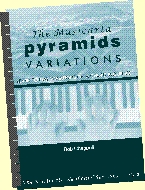
KEY CHORDS VOL.1






